Wireless network Concepts Assignment
VerifiedAdded on 2021/06/18
|11
|2890
|43
AI Summary
Contribute Materials
Your contribution can guide someone’s learning journey. Share your
documents today.
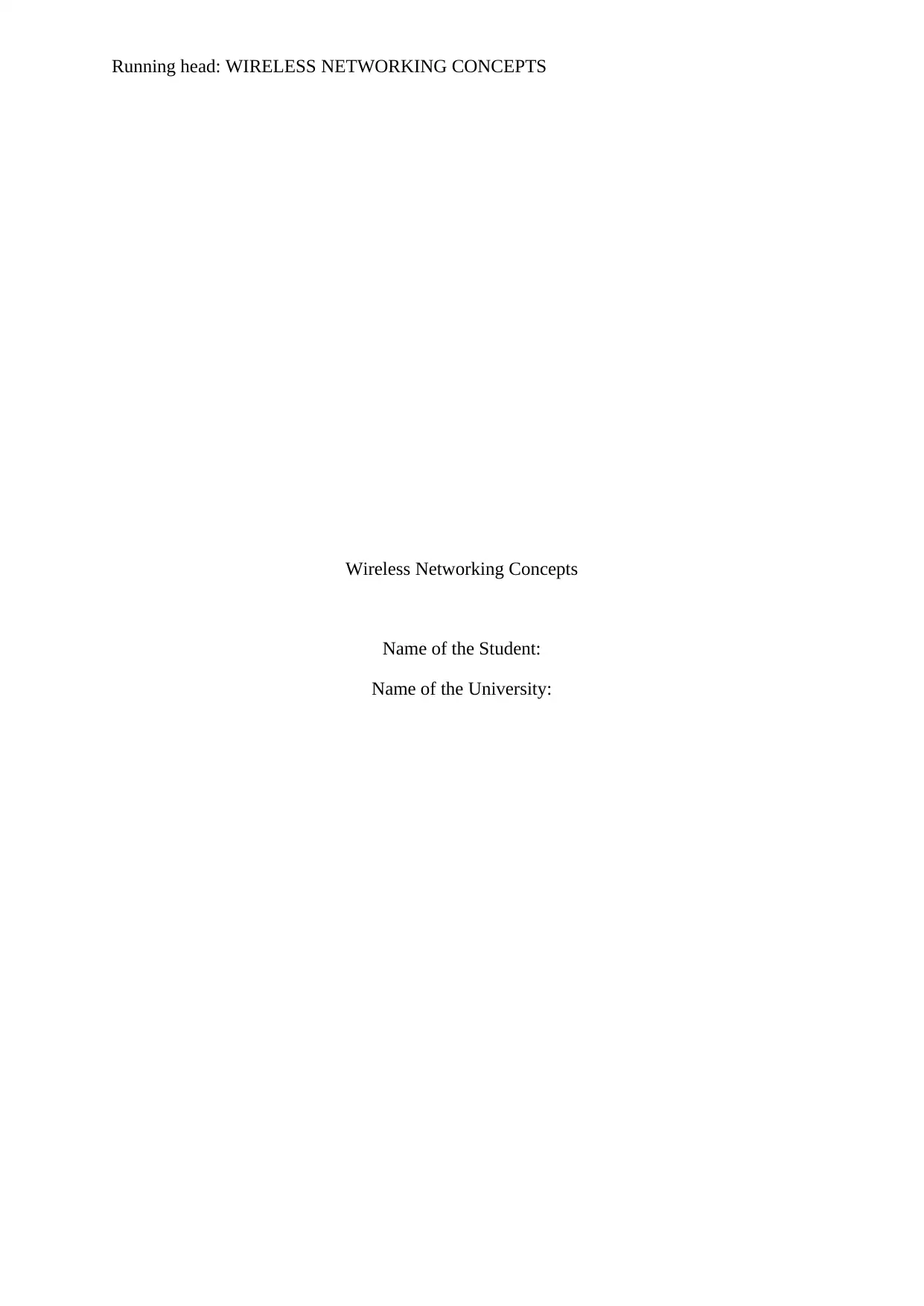
Running head: WIRELESS NETWORKING CONCEPTS
Wireless Networking Concepts
Name of the Student:
Name of the University:
Wireless Networking Concepts
Name of the Student:
Name of the University:
Secure Best Marks with AI Grader
Need help grading? Try our AI Grader for instant feedback on your assignments.
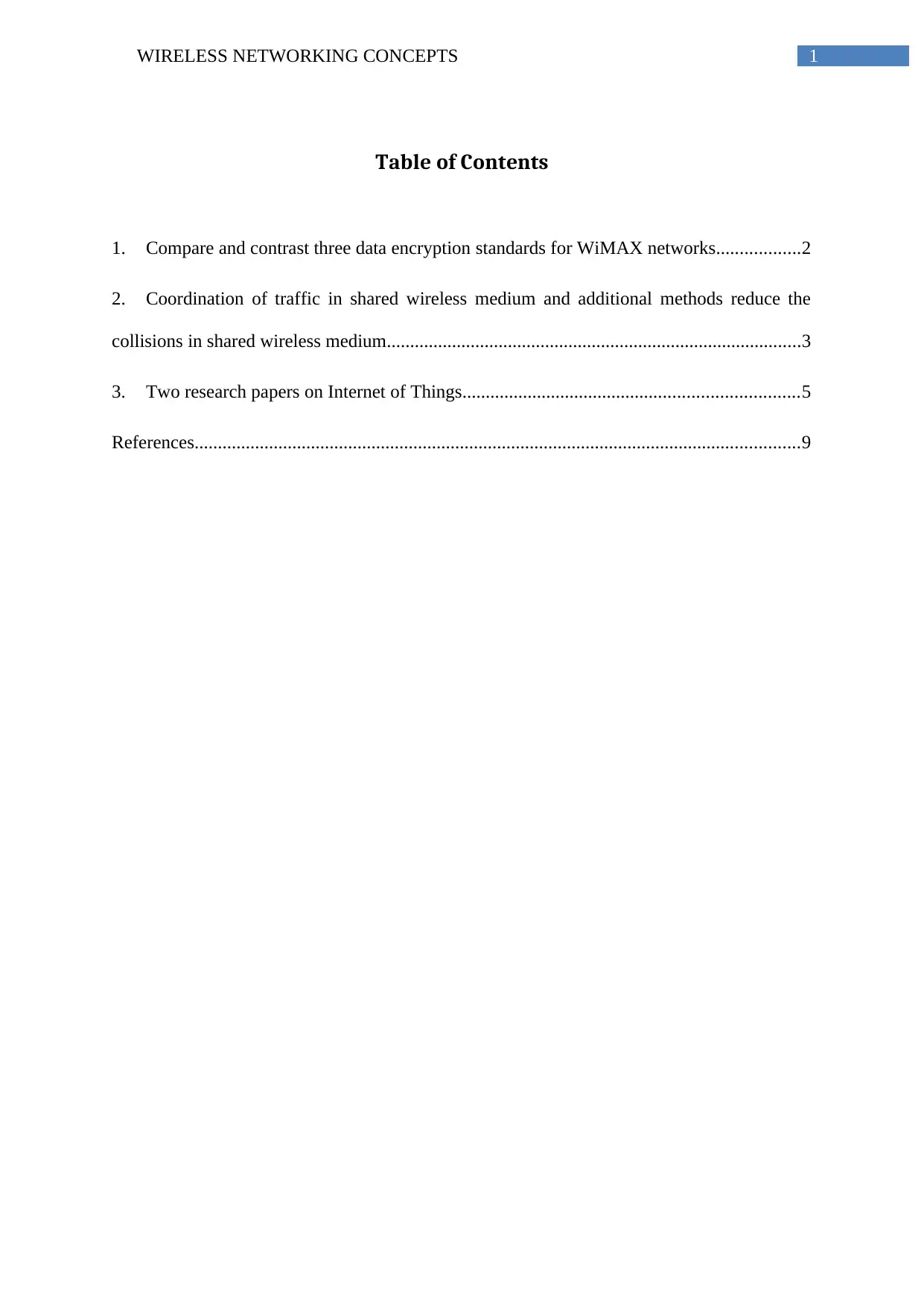
1WIRELESS NETWORKING CONCEPTS
Table of Contents
1. Compare and contrast three data encryption standards for WiMAX networks..................2
2. Coordination of traffic in shared wireless medium and additional methods reduce the
collisions in shared wireless medium.........................................................................................3
3. Two research papers on Internet of Things........................................................................5
References..................................................................................................................................9
Table of Contents
1. Compare and contrast three data encryption standards for WiMAX networks..................2
2. Coordination of traffic in shared wireless medium and additional methods reduce the
collisions in shared wireless medium.........................................................................................3
3. Two research papers on Internet of Things........................................................................5
References..................................................................................................................................9
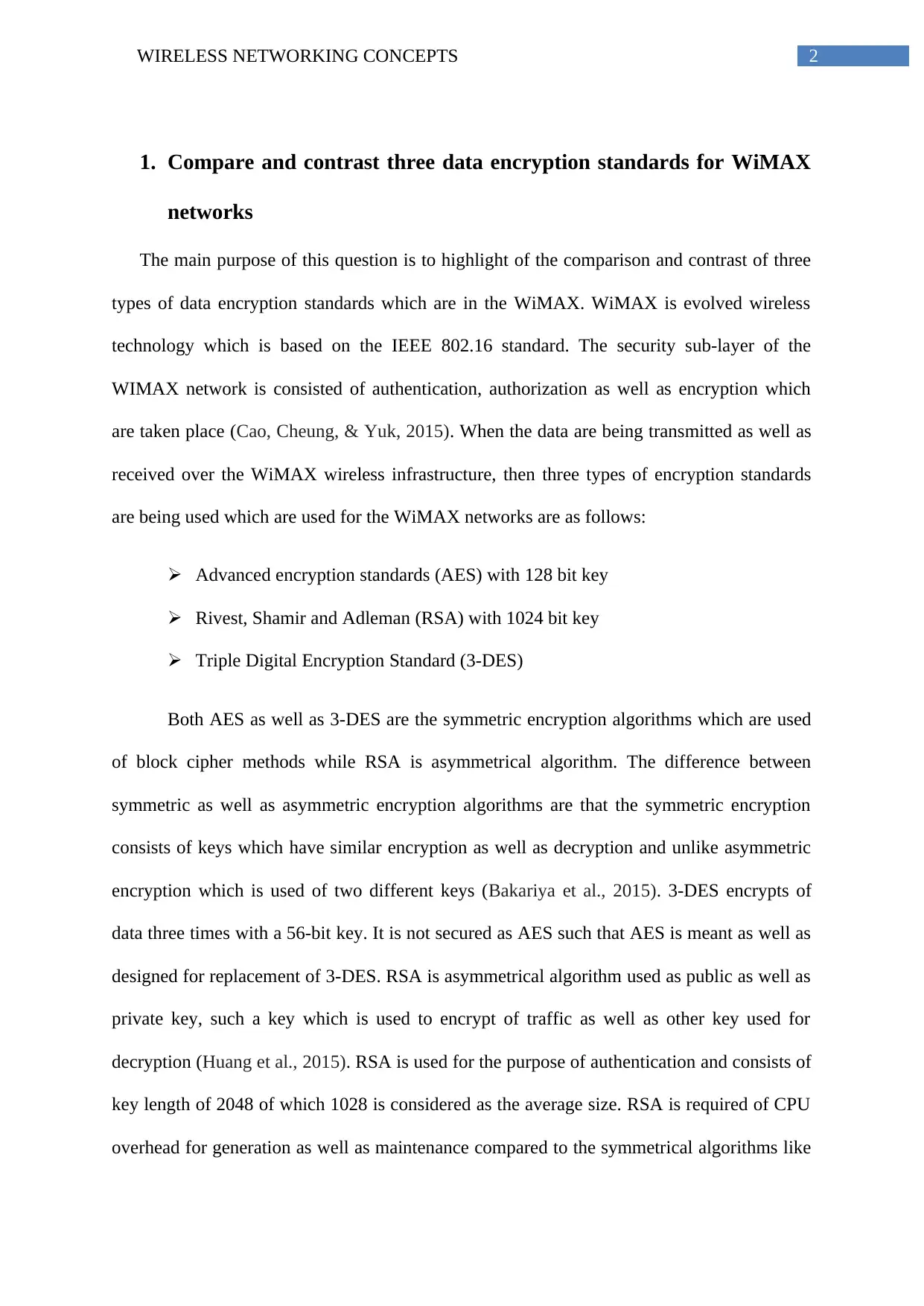
2WIRELESS NETWORKING CONCEPTS
1. Compare and contrast three data encryption standards for WiMAX
networks
The main purpose of this question is to highlight of the comparison and contrast of three
types of data encryption standards which are in the WiMAX. WiMAX is evolved wireless
technology which is based on the IEEE 802.16 standard. The security sub-layer of the
WIMAX network is consisted of authentication, authorization as well as encryption which
are taken place (Cao, Cheung, & Yuk, 2015). When the data are being transmitted as well as
received over the WiMAX wireless infrastructure, then three types of encryption standards
are being used which are used for the WiMAX networks are as follows:
Advanced encryption standards (AES) with 128 bit key
Rivest, Shamir and Adleman (RSA) with 1024 bit key
Triple Digital Encryption Standard (3-DES)
Both AES as well as 3-DES are the symmetric encryption algorithms which are used
of block cipher methods while RSA is asymmetrical algorithm. The difference between
symmetric as well as asymmetric encryption algorithms are that the symmetric encryption
consists of keys which have similar encryption as well as decryption and unlike asymmetric
encryption which is used of two different keys (Bakariya et al., 2015). 3-DES encrypts of
data three times with a 56-bit key. It is not secured as AES such that AES is meant as well as
designed for replacement of 3-DES. RSA is asymmetrical algorithm used as public as well as
private key, such a key which is used to encrypt of traffic as well as other key used for
decryption (Huang et al., 2015). RSA is used for the purpose of authentication and consists of
key length of 2048 of which 1028 is considered as the average size. RSA is required of CPU
overhead for generation as well as maintenance compared to the symmetrical algorithms like
1. Compare and contrast three data encryption standards for WiMAX
networks
The main purpose of this question is to highlight of the comparison and contrast of three
types of data encryption standards which are in the WiMAX. WiMAX is evolved wireless
technology which is based on the IEEE 802.16 standard. The security sub-layer of the
WIMAX network is consisted of authentication, authorization as well as encryption which
are taken place (Cao, Cheung, & Yuk, 2015). When the data are being transmitted as well as
received over the WiMAX wireless infrastructure, then three types of encryption standards
are being used which are used for the WiMAX networks are as follows:
Advanced encryption standards (AES) with 128 bit key
Rivest, Shamir and Adleman (RSA) with 1024 bit key
Triple Digital Encryption Standard (3-DES)
Both AES as well as 3-DES are the symmetric encryption algorithms which are used
of block cipher methods while RSA is asymmetrical algorithm. The difference between
symmetric as well as asymmetric encryption algorithms are that the symmetric encryption
consists of keys which have similar encryption as well as decryption and unlike asymmetric
encryption which is used of two different keys (Bakariya et al., 2015). 3-DES encrypts of
data three times with a 56-bit key. It is not secured as AES such that AES is meant as well as
designed for replacement of 3-DES. RSA is asymmetrical algorithm used as public as well as
private key, such a key which is used to encrypt of traffic as well as other key used for
decryption (Huang et al., 2015). RSA is used for the purpose of authentication and consists of
key length of 2048 of which 1028 is considered as the average size. RSA is required of CPU
overhead for generation as well as maintenance compared to the symmetrical algorithms like
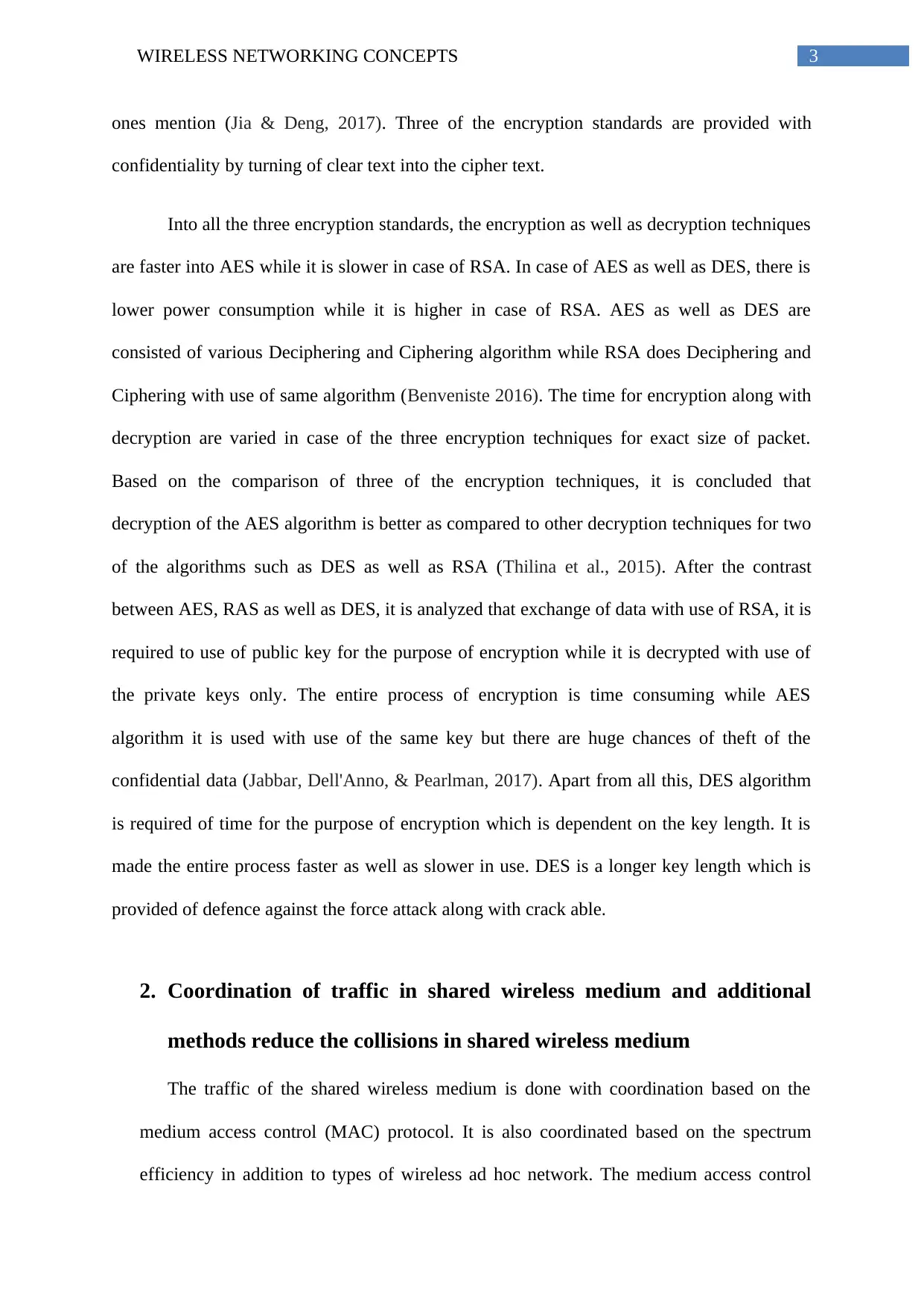
3WIRELESS NETWORKING CONCEPTS
ones mention (Jia & Deng, 2017). Three of the encryption standards are provided with
confidentiality by turning of clear text into the cipher text.
Into all the three encryption standards, the encryption as well as decryption techniques
are faster into AES while it is slower in case of RSA. In case of AES as well as DES, there is
lower power consumption while it is higher in case of RSA. AES as well as DES are
consisted of various Deciphering and Ciphering algorithm while RSA does Deciphering and
Ciphering with use of same algorithm (Benveniste 2016). The time for encryption along with
decryption are varied in case of the three encryption techniques for exact size of packet.
Based on the comparison of three of the encryption techniques, it is concluded that
decryption of the AES algorithm is better as compared to other decryption techniques for two
of the algorithms such as DES as well as RSA (Thilina et al., 2015). After the contrast
between AES, RAS as well as DES, it is analyzed that exchange of data with use of RSA, it is
required to use of public key for the purpose of encryption while it is decrypted with use of
the private keys only. The entire process of encryption is time consuming while AES
algorithm it is used with use of the same key but there are huge chances of theft of the
confidential data (Jabbar, Dell'Anno, & Pearlman, 2017). Apart from all this, DES algorithm
is required of time for the purpose of encryption which is dependent on the key length. It is
made the entire process faster as well as slower in use. DES is a longer key length which is
provided of defence against the force attack along with crack able.
2. Coordination of traffic in shared wireless medium and additional
methods reduce the collisions in shared wireless medium
The traffic of the shared wireless medium is done with coordination based on the
medium access control (MAC) protocol. It is also coordinated based on the spectrum
efficiency in addition to types of wireless ad hoc network. The medium access control
ones mention (Jia & Deng, 2017). Three of the encryption standards are provided with
confidentiality by turning of clear text into the cipher text.
Into all the three encryption standards, the encryption as well as decryption techniques
are faster into AES while it is slower in case of RSA. In case of AES as well as DES, there is
lower power consumption while it is higher in case of RSA. AES as well as DES are
consisted of various Deciphering and Ciphering algorithm while RSA does Deciphering and
Ciphering with use of same algorithm (Benveniste 2016). The time for encryption along with
decryption are varied in case of the three encryption techniques for exact size of packet.
Based on the comparison of three of the encryption techniques, it is concluded that
decryption of the AES algorithm is better as compared to other decryption techniques for two
of the algorithms such as DES as well as RSA (Thilina et al., 2015). After the contrast
between AES, RAS as well as DES, it is analyzed that exchange of data with use of RSA, it is
required to use of public key for the purpose of encryption while it is decrypted with use of
the private keys only. The entire process of encryption is time consuming while AES
algorithm it is used with use of the same key but there are huge chances of theft of the
confidential data (Jabbar, Dell'Anno, & Pearlman, 2017). Apart from all this, DES algorithm
is required of time for the purpose of encryption which is dependent on the key length. It is
made the entire process faster as well as slower in use. DES is a longer key length which is
provided of defence against the force attack along with crack able.
2. Coordination of traffic in shared wireless medium and additional
methods reduce the collisions in shared wireless medium
The traffic of the shared wireless medium is done with coordination based on the
medium access control (MAC) protocol. It is also coordinated based on the spectrum
efficiency in addition to types of wireless ad hoc network. The medium access control
Secure Best Marks with AI Grader
Need help grading? Try our AI Grader for instant feedback on your assignments.
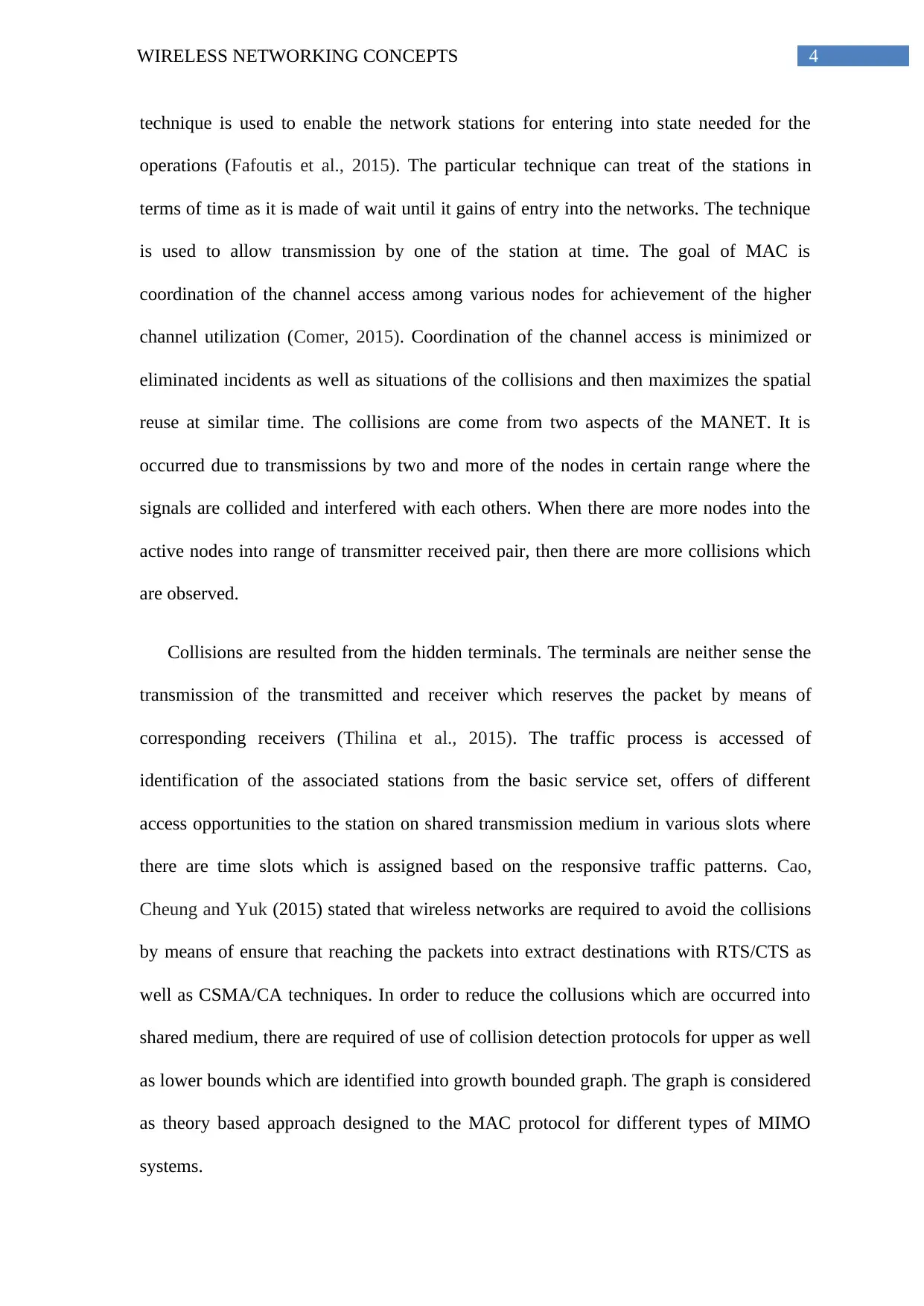
4WIRELESS NETWORKING CONCEPTS
technique is used to enable the network stations for entering into state needed for the
operations (Fafoutis et al., 2015). The particular technique can treat of the stations in
terms of time as it is made of wait until it gains of entry into the networks. The technique
is used to allow transmission by one of the station at time. The goal of MAC is
coordination of the channel access among various nodes for achievement of the higher
channel utilization (Comer, 2015). Coordination of the channel access is minimized or
eliminated incidents as well as situations of the collisions and then maximizes the spatial
reuse at similar time. The collisions are come from two aspects of the MANET. It is
occurred due to transmissions by two and more of the nodes in certain range where the
signals are collided and interfered with each others. When there are more nodes into the
active nodes into range of transmitter received pair, then there are more collisions which
are observed.
Collisions are resulted from the hidden terminals. The terminals are neither sense the
transmission of the transmitted and receiver which reserves the packet by means of
corresponding receivers (Thilina et al., 2015). The traffic process is accessed of
identification of the associated stations from the basic service set, offers of different
access opportunities to the station on shared transmission medium in various slots where
there are time slots which is assigned based on the responsive traffic patterns. Cao,
Cheung and Yuk (2015) stated that wireless networks are required to avoid the collisions
by means of ensure that reaching the packets into extract destinations with RTS/CTS as
well as CSMA/CA techniques. In order to reduce the collusions which are occurred into
shared medium, there are required of use of collision detection protocols for upper as well
as lower bounds which are identified into growth bounded graph. The graph is considered
as theory based approach designed to the MAC protocol for different types of MIMO
systems.
technique is used to enable the network stations for entering into state needed for the
operations (Fafoutis et al., 2015). The particular technique can treat of the stations in
terms of time as it is made of wait until it gains of entry into the networks. The technique
is used to allow transmission by one of the station at time. The goal of MAC is
coordination of the channel access among various nodes for achievement of the higher
channel utilization (Comer, 2015). Coordination of the channel access is minimized or
eliminated incidents as well as situations of the collisions and then maximizes the spatial
reuse at similar time. The collisions are come from two aspects of the MANET. It is
occurred due to transmissions by two and more of the nodes in certain range where the
signals are collided and interfered with each others. When there are more nodes into the
active nodes into range of transmitter received pair, then there are more collisions which
are observed.
Collisions are resulted from the hidden terminals. The terminals are neither sense the
transmission of the transmitted and receiver which reserves the packet by means of
corresponding receivers (Thilina et al., 2015). The traffic process is accessed of
identification of the associated stations from the basic service set, offers of different
access opportunities to the station on shared transmission medium in various slots where
there are time slots which is assigned based on the responsive traffic patterns. Cao,
Cheung and Yuk (2015) stated that wireless networks are required to avoid the collisions
by means of ensure that reaching the packets into extract destinations with RTS/CTS as
well as CSMA/CA techniques. In order to reduce the collusions which are occurred into
shared medium, there are required of use of collision detection protocols for upper as well
as lower bounds which are identified into growth bounded graph. The graph is considered
as theory based approach designed to the MAC protocol for different types of MIMO
systems.
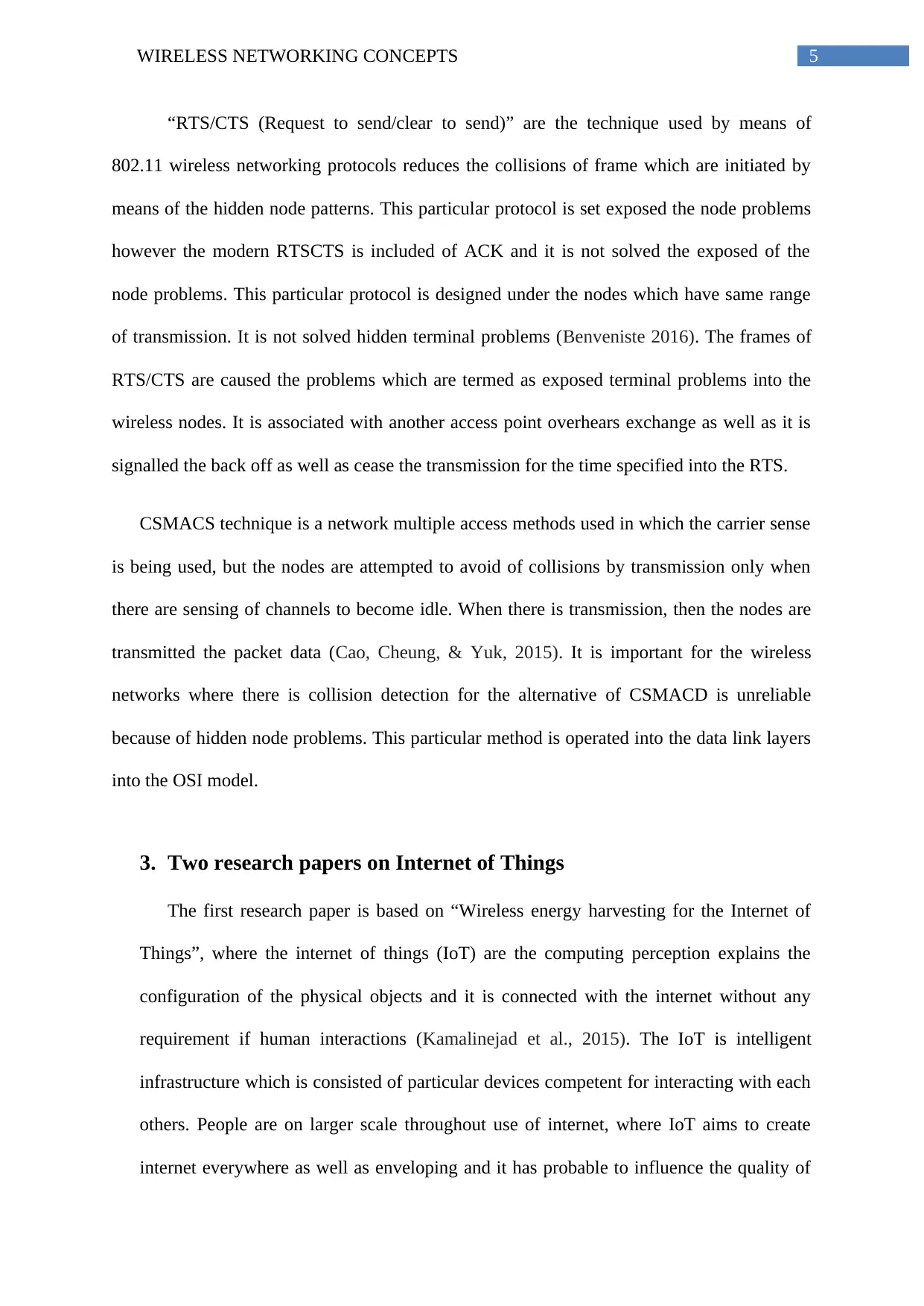
5WIRELESS NETWORKING CONCEPTS
“RTS/CTS (Request to send/clear to send)” are the technique used by means of
802.11 wireless networking protocols reduces the collisions of frame which are initiated by
means of the hidden node patterns. This particular protocol is set exposed the node problems
however the modern RTSCTS is included of ACK and it is not solved the exposed of the
node problems. This particular protocol is designed under the nodes which have same range
of transmission. It is not solved hidden terminal problems (Benveniste 2016). The frames of
RTS/CTS are caused the problems which are termed as exposed terminal problems into the
wireless nodes. It is associated with another access point overhears exchange as well as it is
signalled the back off as well as cease the transmission for the time specified into the RTS.
CSMACS technique is a network multiple access methods used in which the carrier sense
is being used, but the nodes are attempted to avoid of collisions by transmission only when
there are sensing of channels to become idle. When there is transmission, then the nodes are
transmitted the packet data (Cao, Cheung, & Yuk, 2015). It is important for the wireless
networks where there is collision detection for the alternative of CSMACD is unreliable
because of hidden node problems. This particular method is operated into the data link layers
into the OSI model.
3. Two research papers on Internet of Things
The first research paper is based on “Wireless energy harvesting for the Internet of
Things”, where the internet of things (IoT) are the computing perception explains the
configuration of the physical objects and it is connected with the internet without any
requirement if human interactions (Kamalinejad et al., 2015). The IoT is intelligent
infrastructure which is consisted of particular devices competent for interacting with each
others. People are on larger scale throughout use of internet, where IoT aims to create
internet everywhere as well as enveloping and it has probable to influence the quality of
“RTS/CTS (Request to send/clear to send)” are the technique used by means of
802.11 wireless networking protocols reduces the collisions of frame which are initiated by
means of the hidden node patterns. This particular protocol is set exposed the node problems
however the modern RTSCTS is included of ACK and it is not solved the exposed of the
node problems. This particular protocol is designed under the nodes which have same range
of transmission. It is not solved hidden terminal problems (Benveniste 2016). The frames of
RTS/CTS are caused the problems which are termed as exposed terminal problems into the
wireless nodes. It is associated with another access point overhears exchange as well as it is
signalled the back off as well as cease the transmission for the time specified into the RTS.
CSMACS technique is a network multiple access methods used in which the carrier sense
is being used, but the nodes are attempted to avoid of collisions by transmission only when
there are sensing of channels to become idle. When there is transmission, then the nodes are
transmitted the packet data (Cao, Cheung, & Yuk, 2015). It is important for the wireless
networks where there is collision detection for the alternative of CSMACD is unreliable
because of hidden node problems. This particular method is operated into the data link layers
into the OSI model.
3. Two research papers on Internet of Things
The first research paper is based on “Wireless energy harvesting for the Internet of
Things”, where the internet of things (IoT) are the computing perception explains the
configuration of the physical objects and it is connected with the internet without any
requirement if human interactions (Kamalinejad et al., 2015). The IoT is intelligent
infrastructure which is consisted of particular devices competent for interacting with each
others. People are on larger scale throughout use of internet, where IoT aims to create
internet everywhere as well as enveloping and it has probable to influence the quality of
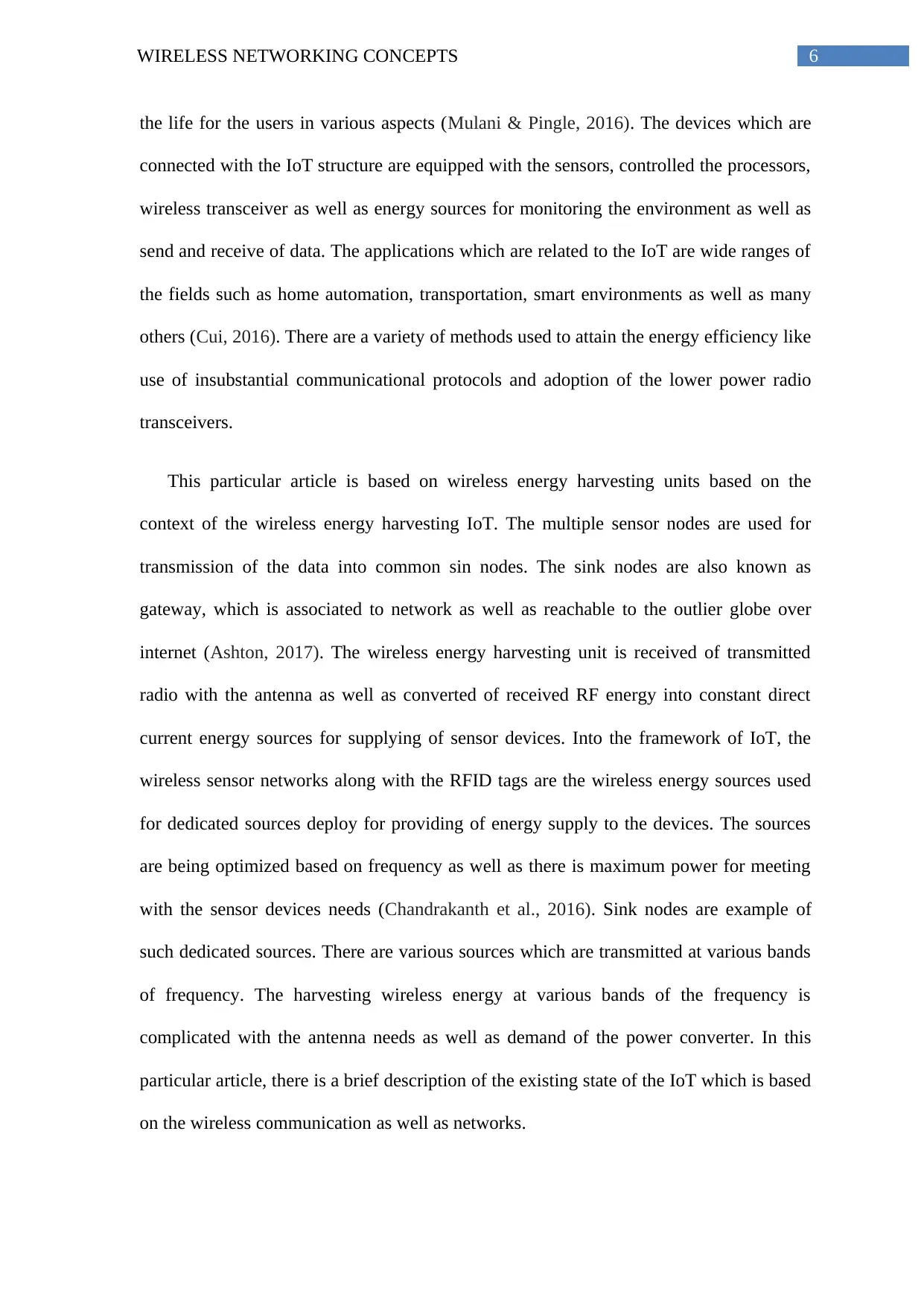
6WIRELESS NETWORKING CONCEPTS
the life for the users in various aspects (Mulani & Pingle, 2016). The devices which are
connected with the IoT structure are equipped with the sensors, controlled the processors,
wireless transceiver as well as energy sources for monitoring the environment as well as
send and receive of data. The applications which are related to the IoT are wide ranges of
the fields such as home automation, transportation, smart environments as well as many
others (Cui, 2016). There are a variety of methods used to attain the energy efficiency like
use of insubstantial communicational protocols and adoption of the lower power radio
transceivers.
This particular article is based on wireless energy harvesting units based on the
context of the wireless energy harvesting IoT. The multiple sensor nodes are used for
transmission of the data into common sin nodes. The sink nodes are also known as
gateway, which is associated to network as well as reachable to the outlier globe over
internet (Ashton, 2017). The wireless energy harvesting unit is received of transmitted
radio with the antenna as well as converted of received RF energy into constant direct
current energy sources for supplying of sensor devices. Into the framework of IoT, the
wireless sensor networks along with the RFID tags are the wireless energy sources used
for dedicated sources deploy for providing of energy supply to the devices. The sources
are being optimized based on frequency as well as there is maximum power for meeting
with the sensor devices needs (Chandrakanth et al., 2016). Sink nodes are example of
such dedicated sources. There are various sources which are transmitted at various bands
of frequency. The harvesting wireless energy at various bands of the frequency is
complicated with the antenna needs as well as demand of the power converter. In this
particular article, there is a brief description of the existing state of the IoT which is based
on the wireless communication as well as networks.
the life for the users in various aspects (Mulani & Pingle, 2016). The devices which are
connected with the IoT structure are equipped with the sensors, controlled the processors,
wireless transceiver as well as energy sources for monitoring the environment as well as
send and receive of data. The applications which are related to the IoT are wide ranges of
the fields such as home automation, transportation, smart environments as well as many
others (Cui, 2016). There are a variety of methods used to attain the energy efficiency like
use of insubstantial communicational protocols and adoption of the lower power radio
transceivers.
This particular article is based on wireless energy harvesting units based on the
context of the wireless energy harvesting IoT. The multiple sensor nodes are used for
transmission of the data into common sin nodes. The sink nodes are also known as
gateway, which is associated to network as well as reachable to the outlier globe over
internet (Ashton, 2017). The wireless energy harvesting unit is received of transmitted
radio with the antenna as well as converted of received RF energy into constant direct
current energy sources for supplying of sensor devices. Into the framework of IoT, the
wireless sensor networks along with the RFID tags are the wireless energy sources used
for dedicated sources deploy for providing of energy supply to the devices. The sources
are being optimized based on frequency as well as there is maximum power for meeting
with the sensor devices needs (Chandrakanth et al., 2016). Sink nodes are example of
such dedicated sources. There are various sources which are transmitted at various bands
of frequency. The harvesting wireless energy at various bands of the frequency is
complicated with the antenna needs as well as demand of the power converter. In this
particular article, there is a brief description of the existing state of the IoT which is based
on the wireless communication as well as networks.
Paraphrase This Document
Need a fresh take? Get an instant paraphrase of this document with our AI Paraphraser
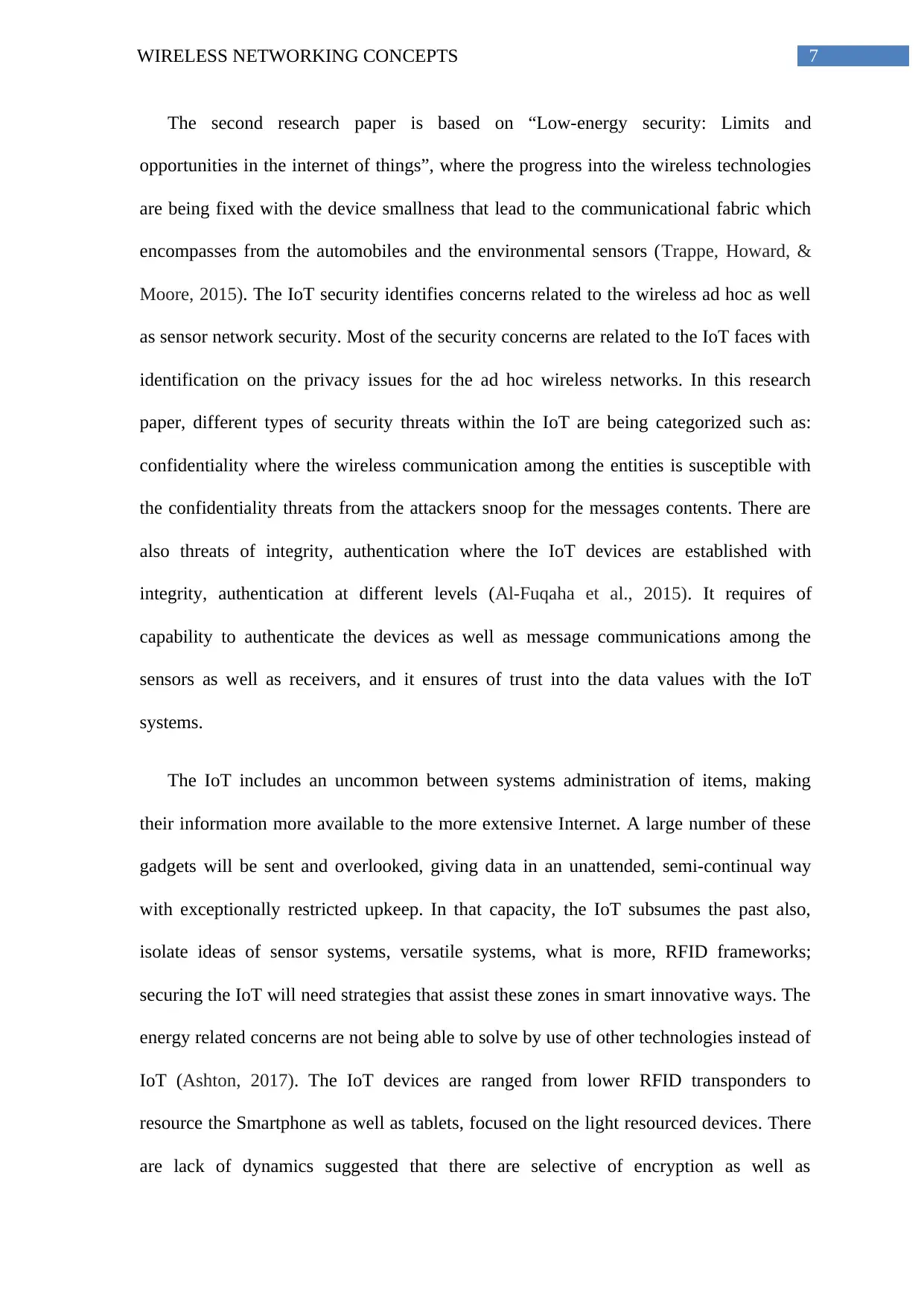
7WIRELESS NETWORKING CONCEPTS
The second research paper is based on “Low-energy security: Limits and
opportunities in the internet of things”, where the progress into the wireless technologies
are being fixed with the device smallness that lead to the communicational fabric which
encompasses from the automobiles and the environmental sensors (Trappe, Howard, &
Moore, 2015). The IoT security identifies concerns related to the wireless ad hoc as well
as sensor network security. Most of the security concerns are related to the IoT faces with
identification on the privacy issues for the ad hoc wireless networks. In this research
paper, different types of security threats within the IoT are being categorized such as:
confidentiality where the wireless communication among the entities is susceptible with
the confidentiality threats from the attackers snoop for the messages contents. There are
also threats of integrity, authentication where the IoT devices are established with
integrity, authentication at different levels (Al-Fuqaha et al., 2015). It requires of
capability to authenticate the devices as well as message communications among the
sensors as well as receivers, and it ensures of trust into the data values with the IoT
systems.
The IoT includes an uncommon between systems administration of items, making
their information more available to the more extensive Internet. A large number of these
gadgets will be sent and overlooked, giving data in an unattended, semi-continual way
with exceptionally restricted upkeep. In that capacity, the IoT subsumes the past also,
isolate ideas of sensor systems, versatile systems, what is more, RFID frameworks;
securing the IoT will need strategies that assist these zones in smart innovative ways. The
energy related concerns are not being able to solve by use of other technologies instead of
IoT (Ashton, 2017). The IoT devices are ranged from lower RFID transponders to
resource the Smartphone as well as tablets, focused on the light resourced devices. There
are lack of dynamics suggested that there are selective of encryption as well as
The second research paper is based on “Low-energy security: Limits and
opportunities in the internet of things”, where the progress into the wireless technologies
are being fixed with the device smallness that lead to the communicational fabric which
encompasses from the automobiles and the environmental sensors (Trappe, Howard, &
Moore, 2015). The IoT security identifies concerns related to the wireless ad hoc as well
as sensor network security. Most of the security concerns are related to the IoT faces with
identification on the privacy issues for the ad hoc wireless networks. In this research
paper, different types of security threats within the IoT are being categorized such as:
confidentiality where the wireless communication among the entities is susceptible with
the confidentiality threats from the attackers snoop for the messages contents. There are
also threats of integrity, authentication where the IoT devices are established with
integrity, authentication at different levels (Al-Fuqaha et al., 2015). It requires of
capability to authenticate the devices as well as message communications among the
sensors as well as receivers, and it ensures of trust into the data values with the IoT
systems.
The IoT includes an uncommon between systems administration of items, making
their information more available to the more extensive Internet. A large number of these
gadgets will be sent and overlooked, giving data in an unattended, semi-continual way
with exceptionally restricted upkeep. In that capacity, the IoT subsumes the past also,
isolate ideas of sensor systems, versatile systems, what is more, RFID frameworks;
securing the IoT will need strategies that assist these zones in smart innovative ways. The
energy related concerns are not being able to solve by use of other technologies instead of
IoT (Ashton, 2017). The IoT devices are ranged from lower RFID transponders to
resource the Smartphone as well as tablets, focused on the light resourced devices. There
are lack of dynamics suggested that there are selective of encryption as well as

8WIRELESS NETWORKING CONCEPTS
transmission of achieve of energy economy by staging of the cryptographic processes
when there is major of new data requires to replace. It is included of embedded wireless
devices into unconnected world to which the resource paradigm is distinguished. The
devices ate affordable as well as it is limited to the terms of the energy, size, and storage
as well as computing.
transmission of achieve of energy economy by staging of the cryptographic processes
when there is major of new data requires to replace. It is included of embedded wireless
devices into unconnected world to which the resource paradigm is distinguished. The
devices ate affordable as well as it is limited to the terms of the energy, size, and storage
as well as computing.
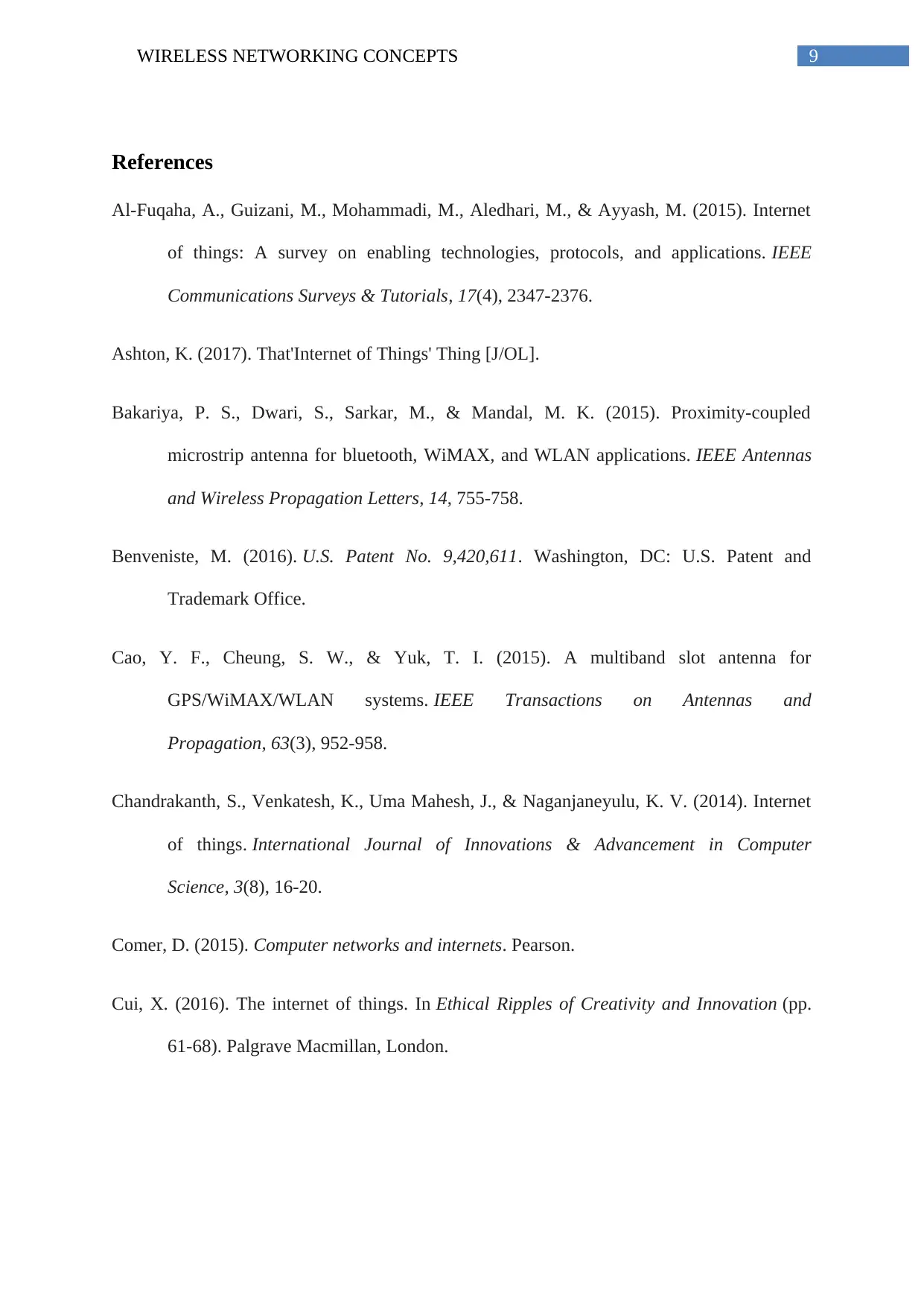
9WIRELESS NETWORKING CONCEPTS
References
Al-Fuqaha, A., Guizani, M., Mohammadi, M., Aledhari, M., & Ayyash, M. (2015). Internet
of things: A survey on enabling technologies, protocols, and applications. IEEE
Communications Surveys & Tutorials, 17(4), 2347-2376.
Ashton, K. (2017). That'Internet of Things' Thing [J/OL].
Bakariya, P. S., Dwari, S., Sarkar, M., & Mandal, M. K. (2015). Proximity-coupled
microstrip antenna for bluetooth, WiMAX, and WLAN applications. IEEE Antennas
and Wireless Propagation Letters, 14, 755-758.
Benveniste, M. (2016). U.S. Patent No. 9,420,611. Washington, DC: U.S. Patent and
Trademark Office.
Cao, Y. F., Cheung, S. W., & Yuk, T. I. (2015). A multiband slot antenna for
GPS/WiMAX/WLAN systems. IEEE Transactions on Antennas and
Propagation, 63(3), 952-958.
Chandrakanth, S., Venkatesh, K., Uma Mahesh, J., & Naganjaneyulu, K. V. (2014). Internet
of things. International Journal of Innovations & Advancement in Computer
Science, 3(8), 16-20.
Comer, D. (2015). Computer networks and internets. Pearson.
Cui, X. (2016). The internet of things. In Ethical Ripples of Creativity and Innovation (pp.
61-68). Palgrave Macmillan, London.
References
Al-Fuqaha, A., Guizani, M., Mohammadi, M., Aledhari, M., & Ayyash, M. (2015). Internet
of things: A survey on enabling technologies, protocols, and applications. IEEE
Communications Surveys & Tutorials, 17(4), 2347-2376.
Ashton, K. (2017). That'Internet of Things' Thing [J/OL].
Bakariya, P. S., Dwari, S., Sarkar, M., & Mandal, M. K. (2015). Proximity-coupled
microstrip antenna for bluetooth, WiMAX, and WLAN applications. IEEE Antennas
and Wireless Propagation Letters, 14, 755-758.
Benveniste, M. (2016). U.S. Patent No. 9,420,611. Washington, DC: U.S. Patent and
Trademark Office.
Cao, Y. F., Cheung, S. W., & Yuk, T. I. (2015). A multiband slot antenna for
GPS/WiMAX/WLAN systems. IEEE Transactions on Antennas and
Propagation, 63(3), 952-958.
Chandrakanth, S., Venkatesh, K., Uma Mahesh, J., & Naganjaneyulu, K. V. (2014). Internet
of things. International Journal of Innovations & Advancement in Computer
Science, 3(8), 16-20.
Comer, D. (2015). Computer networks and internets. Pearson.
Cui, X. (2016). The internet of things. In Ethical Ripples of Creativity and Innovation (pp.
61-68). Palgrave Macmillan, London.
Secure Best Marks with AI Grader
Need help grading? Try our AI Grader for instant feedback on your assignments.
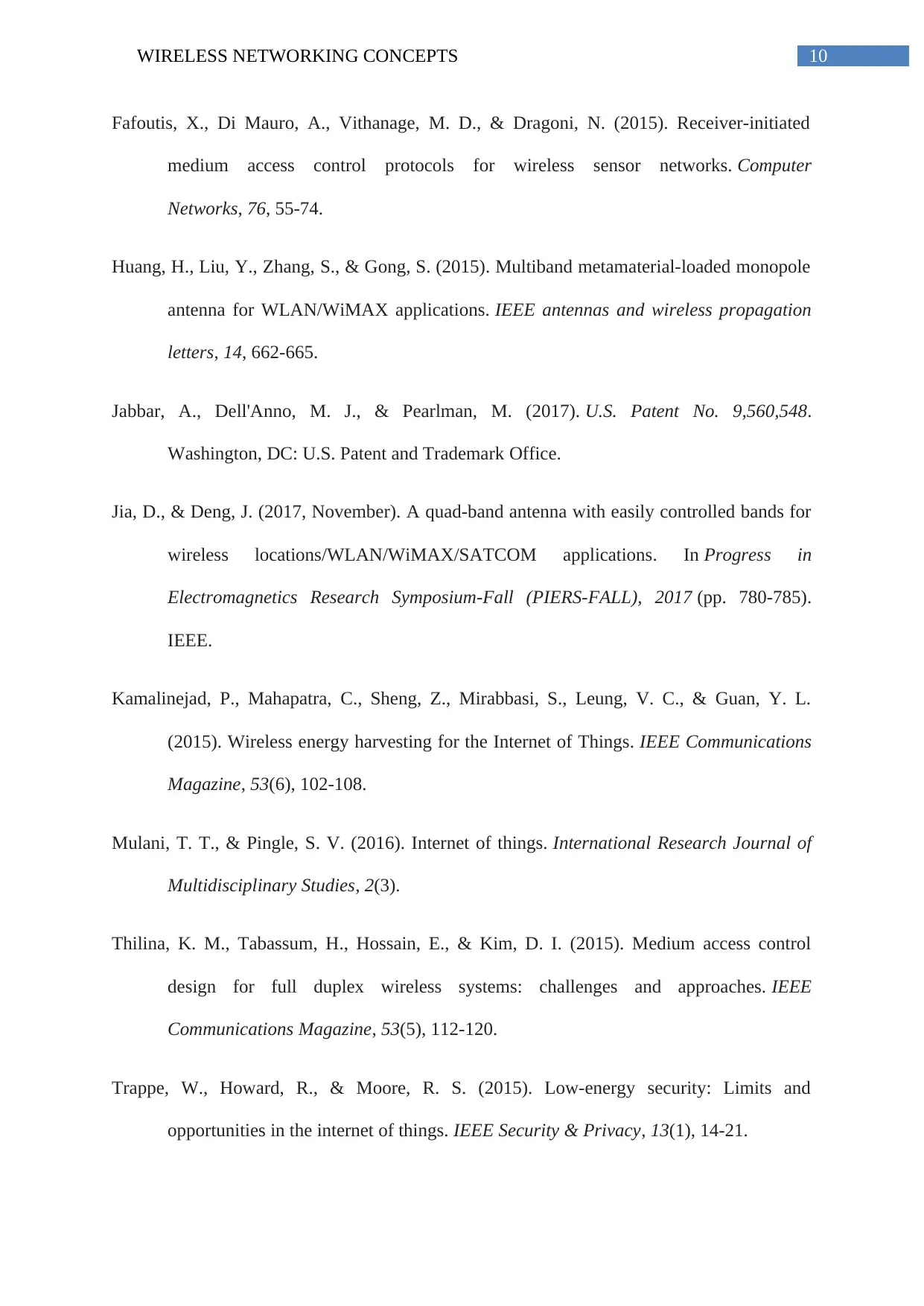
10WIRELESS NETWORKING CONCEPTS
Fafoutis, X., Di Mauro, A., Vithanage, M. D., & Dragoni, N. (2015). Receiver-initiated
medium access control protocols for wireless sensor networks. Computer
Networks, 76, 55-74.
Huang, H., Liu, Y., Zhang, S., & Gong, S. (2015). Multiband metamaterial-loaded monopole
antenna for WLAN/WiMAX applications. IEEE antennas and wireless propagation
letters, 14, 662-665.
Jabbar, A., Dell'Anno, M. J., & Pearlman, M. (2017). U.S. Patent No. 9,560,548.
Washington, DC: U.S. Patent and Trademark Office.
Jia, D., & Deng, J. (2017, November). A quad-band antenna with easily controlled bands for
wireless locations/WLAN/WiMAX/SATCOM applications. In Progress in
Electromagnetics Research Symposium-Fall (PIERS-FALL), 2017 (pp. 780-785).
IEEE.
Kamalinejad, P., Mahapatra, C., Sheng, Z., Mirabbasi, S., Leung, V. C., & Guan, Y. L.
(2015). Wireless energy harvesting for the Internet of Things. IEEE Communications
Magazine, 53(6), 102-108.
Mulani, T. T., & Pingle, S. V. (2016). Internet of things. International Research Journal of
Multidisciplinary Studies, 2(3).
Thilina, K. M., Tabassum, H., Hossain, E., & Kim, D. I. (2015). Medium access control
design for full duplex wireless systems: challenges and approaches. IEEE
Communications Magazine, 53(5), 112-120.
Trappe, W., Howard, R., & Moore, R. S. (2015). Low-energy security: Limits and
opportunities in the internet of things. IEEE Security & Privacy, 13(1), 14-21.
Fafoutis, X., Di Mauro, A., Vithanage, M. D., & Dragoni, N. (2015). Receiver-initiated
medium access control protocols for wireless sensor networks. Computer
Networks, 76, 55-74.
Huang, H., Liu, Y., Zhang, S., & Gong, S. (2015). Multiband metamaterial-loaded monopole
antenna for WLAN/WiMAX applications. IEEE antennas and wireless propagation
letters, 14, 662-665.
Jabbar, A., Dell'Anno, M. J., & Pearlman, M. (2017). U.S. Patent No. 9,560,548.
Washington, DC: U.S. Patent and Trademark Office.
Jia, D., & Deng, J. (2017, November). A quad-band antenna with easily controlled bands for
wireless locations/WLAN/WiMAX/SATCOM applications. In Progress in
Electromagnetics Research Symposium-Fall (PIERS-FALL), 2017 (pp. 780-785).
IEEE.
Kamalinejad, P., Mahapatra, C., Sheng, Z., Mirabbasi, S., Leung, V. C., & Guan, Y. L.
(2015). Wireless energy harvesting for the Internet of Things. IEEE Communications
Magazine, 53(6), 102-108.
Mulani, T. T., & Pingle, S. V. (2016). Internet of things. International Research Journal of
Multidisciplinary Studies, 2(3).
Thilina, K. M., Tabassum, H., Hossain, E., & Kim, D. I. (2015). Medium access control
design for full duplex wireless systems: challenges and approaches. IEEE
Communications Magazine, 53(5), 112-120.
Trappe, W., Howard, R., & Moore, R. S. (2015). Low-energy security: Limits and
opportunities in the internet of things. IEEE Security & Privacy, 13(1), 14-21.
1 out of 11
Related Documents
Your All-in-One AI-Powered Toolkit for Academic Success.
+13062052269
info@desklib.com
Available 24*7 on WhatsApp / Email
![[object Object]](/_next/static/media/star-bottom.7253800d.svg)
Unlock your academic potential
© 2024 | Zucol Services PVT LTD | All rights reserved.





